Pecan Smoked Chicken Wings
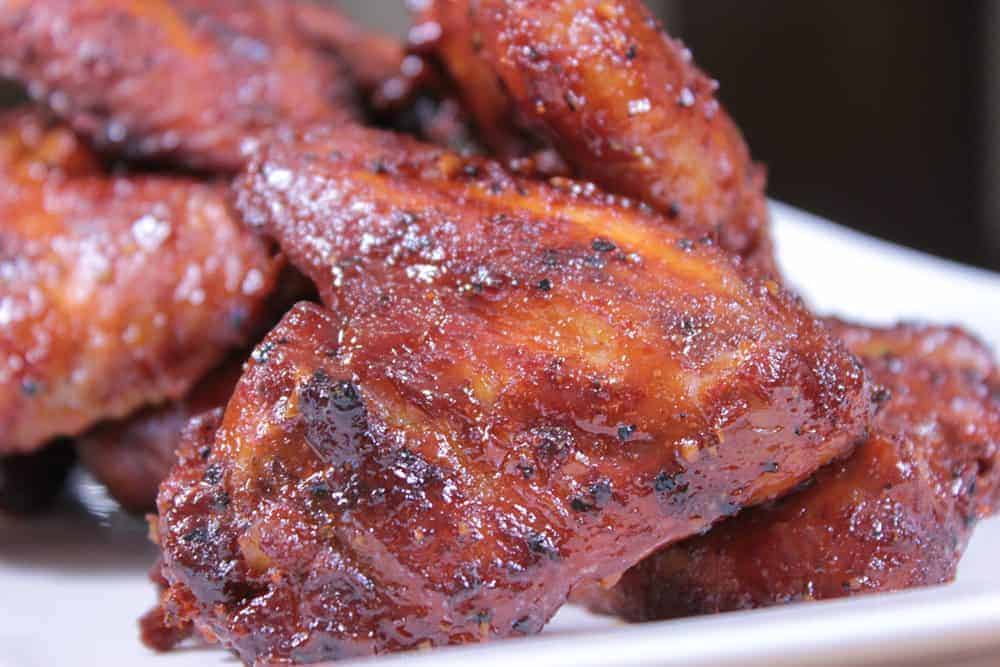
Smoking-Meat.com is supported by its readers. We may earn an affiliate commission at no extra cost to you if you buy through a link on this page.
Read this article without ads
There's not too many foods that I like as well as smoked chicken wings and this week, I just couldn't help showing off my pecan smoked chicken wings with honey and beer barbecue sauce!
The picture looks good enough to eat in my opinion and you can only imagine how good these babies are in real life.
A little sticky and with just the right amount of smoke, the slightly crispy skin is beyond delectable and the tender meat comes cleanly off the bone!
- Prep Time: 10 minutes
- Marinate Time: Overnight or about 6-8 hours
- Cook Time: 2 hours
- Smoker Temp: 225°F
- Meat Finish Temp: 165-170°F
- Recommended Wood: Pecan
- 3 lbs of chicken wings
- Olive oil
- Jeff's original rub
- Jeff's barbecue sauce
- Large ziptop bag
- Beer (almost any kind will work)
- Honey
Rinse the chicken wings under cold water then pat them dry with a paper towel
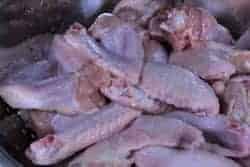
Put the raw chicken wings into a large ziptop bag and pour in about ¼ cup of olive oil.
If you are making more than 3 lb of wings, you may need more oil. The oil is added to create a nice sticky surface on the meat to help the rub to stick well.
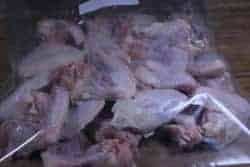
Add about ½ cup of Jeff's original rub to the bag.
Close the bag and shake, rattle, and roll the bag to allow the rub to coat all of the chicken.
Please note: unlike a lot of commercially available rubs, my original rub is low on salt and you can use a lot of this stuff if you want to without worrying that they will be overly salty.
If you did it right, it should look like the picture below:
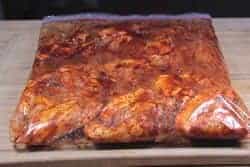
Place the bag of wings into a pan of some sort to ensure that they do not leak and then into the fridge to keep them cold.
Allow them to marinate in the fridge overnight or for 6-8 hours for best results.
The next morning or when you are ready to smoke the chicken wings, remove the bag of wings from the fridge and pour them into a pan so you can easily place them onto the smoker.
As you can see, the rub has turned into a paste consisting of the rub, olive oil and some of the tasty juices from the chicken. They have been marinating all night and some of the goodness has even found it's way up under the skin.
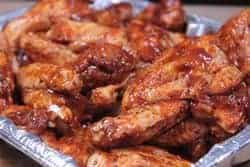
Set up your smoker for cooking at 225°F with indirect heat. If your smoker uses a water pan, leave it empty to help the skin crisp up a little better. Use pecan wood for smoke, if possible (it's awesome on these smoked chicken wings!).
These wings are a great candidate for the Camp Chef Woodwind which not only cooks great but you can go from indirect heat to direct heat in 2 seconds by simply pulling the the grill knob to the left which moves the heat deflector out of the way.
All of a sudden, direct heat is hitting the chicken wings to help finish off that skin right.
You can hit 'em with direct heat for as long as you like, making sure they don't burn then push the grill knob back to the right when you're finished and want to go back to indirect cooking.
Place the chicken wings directly on the smoker grate or you can also use a Bradley rack, Weber grill pan or a cooling rack for easy transport to and from the kitchen.
Smoke the wings with indirect heat. If you are using the BGE, this means you are using the plate setter. In water smokers, you can leave the water pan dry if you like, especially if you have had trouble getting a good texture on the skin.
The first image below is without smoke.. in the 2nd image you can see the hazy pecan smoke starting to come up and kiss the chicken good morning.
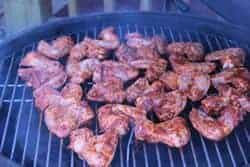
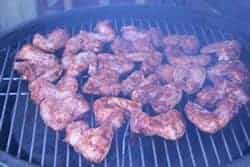
Use pecan wood if you have it and maintain 225 -230°F for about 1.5 to 2 hours.
About 30 minutes before the wings are done cooking, brush the honey and beer barbecue sauce (recipe below) onto the tops of the chicken wings. Let them cook for another 10 minutes then flip them over and repeat on the other side.
You may think it's not going to take nearly 2 hours for these since they will reach about 150°F within the first hour but when you open the lid to sauce them up with the beer and honey barbecue sauce, the temperature will drop several degrees.
It will take another 30 to 45 minutes or more for them to recover and then climb to 165-170°F.
Monitor the Temperature of the Chicken
It is VERY important to monitor the temperature of chicken while you are cooking it.
I know, I know.. you can touch it and tell what temperature it is.
Well, you are my hero but I can't do that accurately enough for my own satisfaction and clear juice does not necessarily mean the chicken has reached a safe temperature.
Use a thermometer and just be on the safe side.
I use the super-fast Thermapen as the final temperature check for things like chicken.
Another great tool is the ThermoPop digital pocket thermometer which reads in 3-4 seconds.
I used the food probe on the Flame Boss temperature controller to monitor an average sized chicken wing, then checked several of the other pieces with my Thermapen once the temperature was reading 165°F.
Using this method, I was able to ensure that all of the chicken was between 165 and 170°F.
My barbecue sauce recipe is great just like it is but it is also a great base for adding other things to.
In this smoked chicken wing recipe, I decided to add a touch of honey and some beer to take it to another level.
To purchase the barbecue sauce recipe with the rub recipe, go HERE.
Once you have the recipe in hand, make up a batch of sauce, let it cool just a little then combine the following:
- 1 cup of Jeff's barbecue sauce
- 2 TBS of honey
- ½ cup of beer
Add the honey and the beer to the barbecue sauce and stir well to combine.
I recommend you “test” a couple or 5 before you take them into the house since after that, they'll be gone like a freight train before you even know what happened!
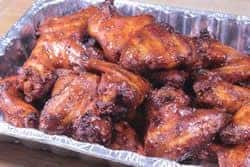
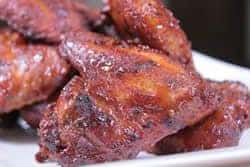
- These smoked chicken wings will not be as crispy as fried wings. They should have decent bite through and if you embrace the quality of chicken skin that's been smoked and coated with a little rub and/or sauce, you might find that while it's different, it's also very, very good ;-)
- You do not have to marinate these overnight but I do highly recommend it. It allows the rub to turn into a paste which wicks up under the skin of the chicken and really gets some good flavor into the outer surface of the meat. You can taste the difference in my opinion.
- I like the full size chicken wings however, if you want the smaller drumettes and wingettes (or whatever they call them), just separate the wings at the elbows before you season them.
- If you must know, I used Shiner Bock beer in the honey and beer barbecue sauce and it is my usual go-to beer for most of my cooking.
Printable Recipe
Pecan Smoked Chicken Wings
Ingredients
- 3 lbs of chicken wings
- Olive oil
- Jeff's original rub
- Jeff's barbecue sauce
- Large ziptop bag
- Beer (almost any kind will work)
- Honey
Instructions
Season up the Chicken Wings
- Rinse the chicken wings under cold water then pat them dry with a paper towel
- Put the raw chicken wings into a large ziptop bag and pour in about ¼ cup of olive oil.
- Add about ½ cup of Jeff's original rub (per 3 lbs of chicken wings) to the bag.
- Close the bag and shake, rattle, and roll the bag to allow the rub to coat all of the chicken.
Marinate Chicken Wings Overnight
- Place the bag of wings into a pan of some sort to ensure that they do not leak and then into the fridge to keep them cold.
- Allow them to marinate in the fridge overnight or for 6-8 hours for best results.
- The next morning or when you are ready to smoke the chicken wings, remove the bag of wings from the fridge and pour them into a pan so you can easily place them onto the smoker.
Smoking the Chicken Wings
- Set up your smoker for cooking at 225 °F with pecan wood if possible (it’s awesome on these smoked chicken wings!).
- Smoke the wings with indirect heat and leave the water pan dry to give the skin a better texture with less humidity.
- Use pecan wood if you have it and maintain 225 -230 °F for about 1.5 to 2 hours.
- About 30 minutes before the wings are done cooking, brush the honey and beer barbecue sauce (recipe below) onto the tops of the chicken wings.
- Let them cook for another 10 minutes then flip them over and repeat on the other side.
- Cook the chicken until it measures 165°F as measured by a tested digital probe meat thermometer.
Making the Beer and Honey Barbecue Sauce
- Combine 1 cup of Jeff's barbecue sauce, 2 TBS of honey and ½ cup of beer until it is well mixed.
- Enjoy!


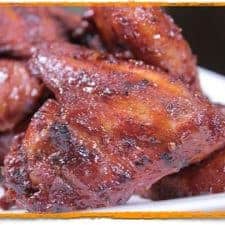
Jeff, how do you clean you smoker???
Mel, this sort of depends on the smoker. I spend about 30 minutes cleaning my smoker after every use and it just makes me happy knowing it’s clean and ready for the next use.I am most concerned with the grates which I try to run through the dishwasher if they will fit. If not, it’s a scrub brush and hot, soapy water to get them clean after every use. Other than that, I spend a few minutes giving the outside a good wiping down, wiping up any grease that may have splattered on the walls or on the bottom. If there’s any glass in the door, it gets cleaned with glass cleaner.Ashes are cleaned out as needed, just have to make sure it’s not blocking airflow. I keep covers on all of the smokers I have outdoors except for the Big Green Egg. Other than that, I do a once a year clean on my smokers where I clean them from top to bottom.. they are so clean I have to re-season them before they can be used. I have a lot of companies that send me smokers to use and I am really big about keeping them pristine but I don’t expect the average outdoor chef is going to spend as much time as I do, I just enjoy the process personally. My smokers that have electronics such as the Woodwind, the Woodwind SG, the Smokin-it 2D, the Bradley, the REC TEC Bull, etc. get treated a little better than the ones that are just metal and burn charcoal and/or wood.
What’s the point of posting a recipe if you have to buy most of the recipe….
Norm, The only thing I sell are my rub recipes and my sauce recipe which helps to support the website. Obviously, if you want to use something from your local grocery store or even just salt and pepper you can do that. I don’t think it will taste nearly as good but I am very biased ;-)
Jeff, curious as to why you wouldn’t use a wireless thermoprobe to monitor temperatures.
Cheers
good stuff